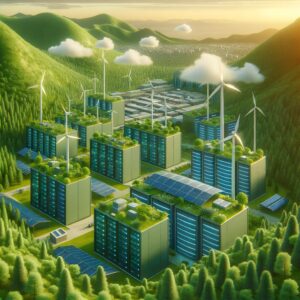From Servers to Sustainability: The Transition to Green Data Centres

A greener future?
In today’s rapidly evolving digital world, data centres have completely transformed the way we live and do business. They’ve allowed us to make video calls, send emails and save files to the cloud. But there’s a catch – these data centres and data transmission networks consume a huge amount of energy. Here’s a staggering fact: In 2022, data centres worldwide guzzled between 240 and 340 TWh1 of electricity, according to the International Energy Agency (IEA). That is up to “1-1.3% of global final electricity demand.” With AI, blockchain, cloud gaming, big data and more businesses migrating to the cloud, the number is only going to rise.
Conventional data centres have high power demands for both their operation and cooling systems. They use a large amount of energy for computing, networking and data storage. Data centres are also notorious for generating enormous heat and keeping them from overheating requires energy-intensive air conditioning systems. It is no wonder companies are looking to find ways to make their operations more energy-efficient, cost-effective and achieve environmental sustainability. As the appetite for the cloud grows, the pressing need for sustainable solutions becomes ever more critical. The move towards greener data centres is one key initiative aimed at lowering our carbon footprint, whilst simultaneously revolutionising the world of the cloud.
What Exactly are Green Data Centres?
Green Data centres are facilities that focus on energy efficiency, sustainable design, and tapping into renewable energy sources, such as wind, solar and hydroelectric power. They use various energy-efficient technologies to cut down energy consumption and minimise carbon impact.
Sustainable data centres aim to reduce carbon emissions by reassessing factors like the location of facilities and efficient cooling systems, while still meeting the growing need for cloud computing and storage. The main objective is to minimise their environmental impact, without compromising performance, reliability and durability.
Energy-Efficient Technologies and Data Centres
Several technologies are paving the way towards decreased energy usage in data centres, promoting a shift to more sustainable practices, and, hopefully, a greener future. One of the most energy-consuming aspects of operating a data centre is the need to cool servers and prevent overheating. Advanced cooling systems that use liquid cooling (water) to directly absorb heat from servers, rather than relying on power-hungry air conditioning, deliver precise temperature control and reduce energy consumption.
Additionally, artificial intelligence and machine learning are being leveraged to enhance real-time energy efficiency. They can predict workloads, modify cooling systems and even power down inactive servers to reduce waste. Google, for example, uses AI to monitor its data centres, having managed to reduce cooling energy by 40%.
The Role of Renewable Energy Sources
The shift towards sustainable data centres also hinges on the use of renewable energy sources. Several tech giants are already leading the charge. Microsoft, for instance, has committed to being carbon negative by 2030, meaning they’ll aim to remove more carbon from the atmosphere than they emit. The company is making serious investments in renewable energy, while also experimenting with underwater data centres, making use of ocean water for cooling.
Similarly, Google seeks to power its global operations with carbon-free energy by 2030. In its bid to ensure that its facilities are powered by renewable energy, the company has invested heavily in wind and solar power. Moreover, Amazon Web Services (AWS), is also working towards powering its data centres with 100% renewable energy by 2025. They have already reached 90% and is committed to developing solar farms and wind projects in its ambition to achieve its set targets.
The Future of Green Data Centres
The continued development of energy-saving technologies and the use of renewables is critical to the future of green data. As more businesses prioritise sustainability, the demand for green cloud infrastructure will only continue to grow. Companies are starting to realise that going green is not only beneficial to the planet, but also for their bottom lines. Energy-efficient data centres help reduce operational expenses, lower energy bills, and strategically position businesses to meet future environmental regulations.
Looking ahead, the tech industry is prepared to make significant strides towards a more sustainable future for cloud computing. With advancements in energy-efficient technologies and the increasing reliance on renewable energy, the next decade will likely bring even more breakthroughs. The transition towards green data centres is not just about cutting emissions – it’s about building a sustainable, cost-effective future for both businesses and the planet. With each step forward, we can expect even more progress, shrinking the carbon footprint of our digital lives.
enquiries@trippassociates.co.uk
Martin Tripp Associates is a specialist executive search consultancy. We work globally across the media, information, technology, video games and entertainment sectors, and with some of the world’s biggest brands on communications, digital, marketing and technology roles. Feel free to contact us to discuss.